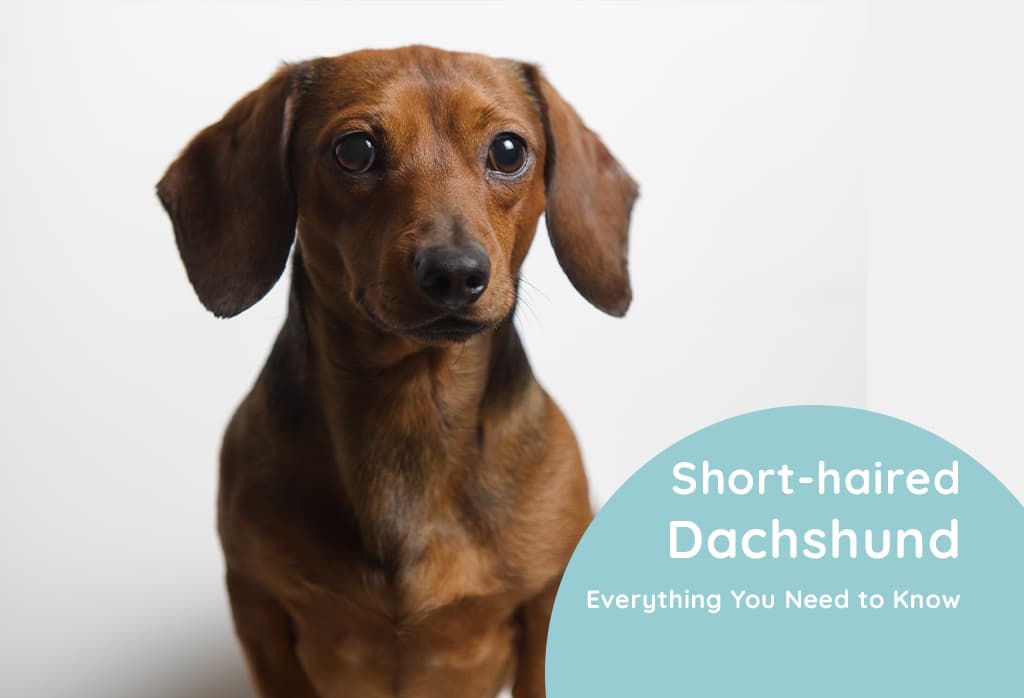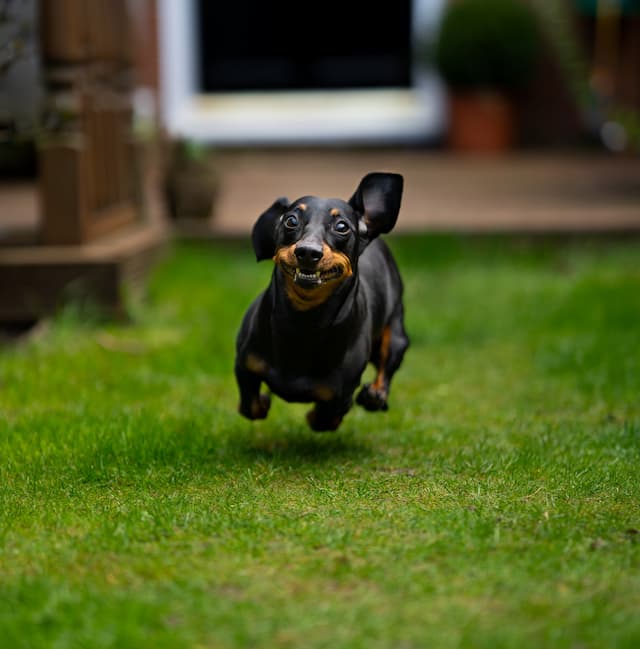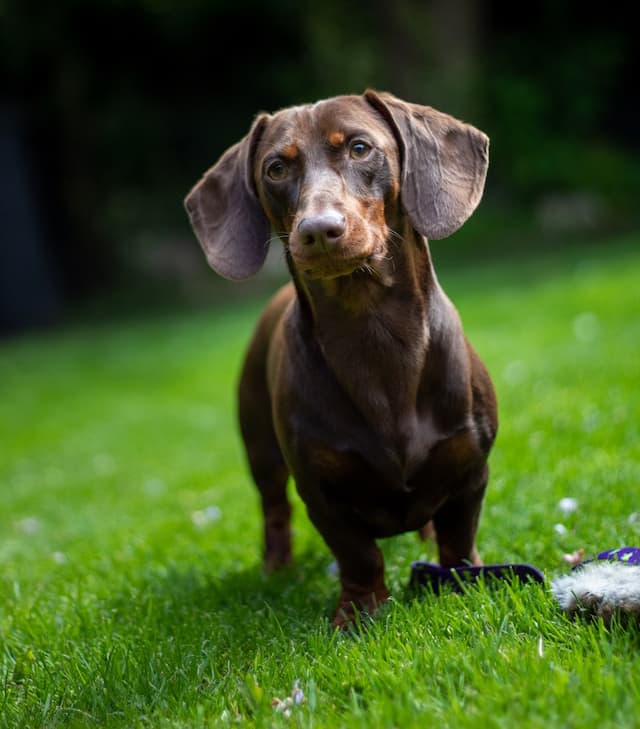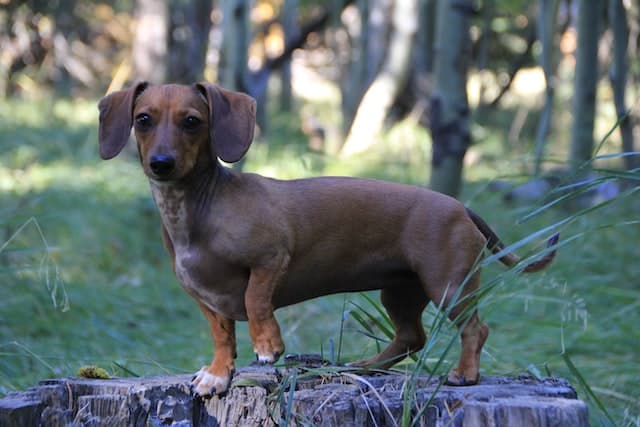Short-haired dachshunds, also known as smooth dachshunds, are a popular breed of dog known for their small size, playful personalities, and unique shape.
These dogs are often called “sausage dogs” or “wiener dogs” due to their elongated body and short legs.
One of the main characteristics of a short-haired dachshund is its coat.
As the name suggests, they have a smooth, short coat that is easy to maintain and groom.
This makes them an excellent option for people needing more time or inclination to groom a dog with a longer coat.
History and Origin
Short-haired dachshunds, also known as smooth dachshunds, have a rich history and origin that dates back to the 16th century.
They were initially bred in Germany, specifically in Bavaria, as hunting dogs.
Their elongated body and short legs were perfect for burrowing and chasing after small animals such as badgers, foxes, and rabbits.
The breed was officially recognized in the late 1800s, and by the early 1900s, they had become famous companion dogs in Europe and America.
Their small size and playful personalities made them a favorite among families and city dwellers.
They were brought to America by German immigrants and quickly became beloved household pets.
Their popularity continued growing, and short-haired dachshunds became one of the most popular breeds in America.
They were often featured in movies and advertisements, making them even more popular.
The American Kennel Club (AKC) officially recognized the breed in 1885, and the breed standard was established.
Since then, short-haired dachshunds have become one of the world’s most recognizable and beloved breeds.
Size and Appearance
Smooth dachshunds are small dogs with unique and distinctive bodies.
They typically stand between 8-11 inches tall and weigh anywhere from 16-32 pounds.
They have a long, sausage-shaped body with short legs and a long tail.
Their coat is short, smooth, and glossy and comes in various colors such as black, brown, red, and tan.
They have a sleek, shiny coat that is easy to maintain and groom.
They require minimal grooming and brushing.
Regular bathing is enough to keep them clean and shiny.
Short-haired dachshunds have long and adorable ears that are often held upright.
Their eyes are large and expressive, and their nose is black and shiny.
They have a long snout that is perfect for digging and burrowing, which is how they were originally used for hunting.
They have a strong and sturdy build, and their legs are short but powerful.
They have a wiry and muscular body that is built for agility and speed.
They have a short, stubby tail that is often held high and wagging.
Short-haired dachshunds are known for their charming and playful personalities, and they have an unmistakable look that is hard to miss.
They are small, but they are packed with energy and personality.
They are a joy to have around and are sure to bring a smile to your face every day.
Colors and Patterns
Short-haired dachshunds come in a variety of beautiful colors and patterns.
Some of the most common colors include:
Black and tan
The black and tan color variety in short-haired dachshunds is one of the breed’s most popular and recognizable color patterns.
A black coat characterizes this color pattern with tan face, legs, and underbelly markings.
This color variation is often referred to as the “traditional” dachshund color and is often seen in show dogs and breeding stock.
One thing to note is that the tan markings on a black and tan dachshund should be distinct and well-defined.
The black coat should also be a deep, rich black color with no fading or discoloration.
Red or sable
The red or sable color in short-haired dachshunds is a beautiful, rich color that ranges from a light, coppery red to a deep, dark red.
A gene-controlling pigment production causes this color in the dog’s coat.
The red or sable dachshunds have a unique and charming appearance that makes them stand out from other colors of this breed.
They are also known to have a friendly and outgoing personalities, which makes them great family pets.
One thing to remember with red or sable dachshunds is that their coat color can change as they age.
This is because the pigmentation in their coat can fade over time, which can result in a lighter color.
However, this is not a health issue and is a natural occurrence in this color variety.
Cream
The Cream color can range from a very light, almost white color to a slightly more golden or apricot color.
It is important to note that cream dachshunds can have different variations of this color, and it can also change over time, becoming more or less intense as the dog ages.
One thing to keep in mind with cream dachshunds is that they are more prone to sunburn and skin cancer, so it is important to protect them from prolonged exposure to the sun.
Keeping their coat well-groomed is also crucial, as their light-colored fur can be prone to discoloration from dirt and debris.
Regarding personality, cream dachshunds are just as loving and loyal as their other colored counterparts.
They make great companion dogs and are known for their playful and affectionate nature.
They are also known for their intelligence and quick learning abilities, making them easy to train and fun to teach new tricks.
Chocolate and tan
Chocolate and tan short-haired dachshunds are a beautiful and unique color variation of the breed.
These dachshunds have a rich chocolate-colored coat with tan markings on their face, legs, and belly.
The chocolate color results from a specific gene responsible for producing the chocolate color in the coat.
This gene can also create variations in the intensity of the chocolate color, from light milk chocolate to a dark chocolate color.
One thing to note with chocolate and tan dachshunds is that they are considered to be a rarer color variation among the breed.
This means that they may be harder to come by and may be more expensive to purchase.
Additionally, it’s important to remember that, like all dachshunds, they have a double coat that requires regular grooming to maintain a healthy shine and prevent matting.
Blue and tan
The Blue and Tan short-haired dachshund is a unique and beautiful color variation of this popular breed.
These dachshunds have a blue-gray coat with tan markings on their face, legs, and underbelly.
The blue color is caused by a genetic dilution of the black coat color and is a rarer variation of the breed.
The Blue and Tan short-haired dachshunds are just as affectionate and playful as their counterparts of other colors.
They are known to be loyal and affectionate with their owners and make great companions.
They are also known to be highly adaptable and can thrive in a variety of living environments.
It is important to note that the blue coat color can be prone to fading over time, especially in areas that are exposed to sunlight.
To maintain the beautiful color of your Blue and Tan short-haired dachshund, it is recommended to keep them indoors or in shaded areas during the hottest part of the day and to use sunblock on their skin.
Temperament
Short-haired are known for their playful and energetic personalities.
They are brilliant dogs that love to play with their owners and other dogs.
They are a very active breed and love to run around, chase balls, and play tug-of-war.
They are also known for their stubbornness and strong-willed personalities, which can make them a bit challenging to train.
Short-haired dachshunds are very loyal and affectionate towards their owners, making great companions for families and single people alike.
They are great with children and other pets and will quickly become a family member.
They are a very social breed and love to be around people and other animals.
Short-haired dachshunds are protective of their owners and home and make excellent watchdogs.
They are known for their sharp bark and protective nature.
They’ll be sure to alert their owners to potential threats, making them excellent watchdogs.
But don’t let their bark fool you.
These pups are also incredibly clever and curious.
They’re natural problem-solvers and quick learners, making training a breeze.
Their intelligence and inquisitive nature will keep them entertained and engaged, making them the perfect companion for anyone looking for an intelligent and loyal pet.
Despite their small size, short-haired dachshunds have a big personalities and a lot of energy.
They need regular exercise and mental stimulation to keep them happy and healthy.
They are best suited for active families or individuals who can provide them with plenty of physical and mental stimulation.
Overall, short-haired dachshunds are a playful, energetic, and affectionate breed that make great companions.
They are loyal, protective, and loving pets that will quickly become a member of the family.
They may be stubborn and strong-willed at times, but they can be trained and well-behaved with patience, consistency, and positive reinforcement.
They’re a bundle of joy and energy, and if you’re looking for a loving and active companion, a short-haired dachshund might be a perfect choice.
Training
Training short-haired dachshunds can be a fun and rewarding experience for you and your furry friend.
These dogs are known for their intelligence and eagerness to please, making them highly trainable.
However, as with any breed, it’s essential to understand their unique characteristics and needs to provide effective training.
One of the most important things to remember when training short-haired dachshunds is their small size.
These dogs are prone to back problems, so it’s important to avoid exercises that put too much strain on their spine.
For example, instead of having them jump up and down from high surfaces, you can teach them to climb up and down using a ramp or stairs.
Another critical aspect of training short-haired dachshunds is their strong-willed nature.
These dogs can be stubborn at times, so it’s important to establish yourself as the leader of the pack and set clear boundaries and rules.
Consistency and positive reinforcement are essential when it comes to training short-haired dachshunds.
Basic obedience training is a great place to start with short-haired dachshunds.
Teaching them commands such as sit, stay, come, heel, and lay down can help establish a strong foundation for more advanced training.
It’s also important to socialize them from a young age to help them become well-adjusted and well-behaved adults.
Potty training
Potty training a short-haired dachshund can be a challenge, but it is definitely doable with patience and consistency!
These little dogs are known for being stubborn and strong-willed, so it’s important to start training them early.
One of the best ways to potty train a short-haired dachshund is using a crate.
This will give them a designated area to go to the bathroom and help prevent accidents in other parts of the house.
When you first bring your short-haired dachshund home, make sure to place the crate in an area that is easily accessible to you.
This will allow you to keep an eye on them and frequently take them out for potty breaks.
Another important aspect of potty training a short-haired dachshund is establishing a routine.
This means taking them out at regular intervals, such as first thing in the morning, after meals, and before bedtime.
Consistency is key when it comes to potty training, so make sure to stick to this schedule as much as possible.
Using positive reinforcement when potty training your short-haired dachshund is also important.
This means rewarding them with treats and praise when they go potty in the designated area.
This will encourage them to continue going to the bathroom in the right place and make the training process more enjoyable for you and your furry friend.
Nutrition
When it comes to feeding your short-haired dachshund, choosing a high-quality, balanced diet that meets their unique nutritional needs is important.
These little pups tend to become overweight, so it’s important to be mindful of their portion sizes and avoid giving them table scraps or too many treats.
One of the most important things to look for in food for short-haired dachshunds is a balance of protein, fat, and carbohydrates.
Protein should be the first ingredient listed, as it’s essential for maintaining strong muscles and a healthy immune system.
Fat should also be included, as it provides energy and helps to keep the coat and skin healthy.
Carbohydrates should be limited, as they can contribute to weight gain.
It’s also a good idea to look for food formulated for small breeds, as these foods are designed to meet the specific nutritional needs of smaller dogs.
Consider the food that is formulated for seniors or overweight dogs, as these foods are typically lower in calories and fat.
In addition to their regular diet, short-haired dachshunds will also benefit from a variety of healthy treats, such as fresh fruits and vegetables, lean protein, and low-fat dairy products.
Be sure to choose treats that are low in calories, as these little pups can quickly become overweight if they consume too many treats.
Feeding your short-haired dachshund a healthy, balanced diet is essential for maintaining their overall health and well-being.
With a little attention and care, you can ensure that your furry friend stays happy, healthy, and full of energy for years to come!
Health Issues
Short-haired dachshunds are generally healthy and hardy dogs.
However, like all breeds, they are prone to specific health issues.
It’s important to be aware of these potential issues to take proper care of your short-haired dachshund and ensure they live long and healthy life.
Back problems
Back problems are a typical health issue in short-haired dachshunds due to their long and sausage-shaped body.
Their back can put stress on their spine and cause issues such as intervertebral disc disease (IVDD).
IVDD is a condition where the discs that cushion the vertebrae in the spine become damaged or ruptured.
This can cause severe pain, mobility issues, and even paralysis.
The most common symptoms of IVDD include reluctance to move, crying out in pain, and stiffness in the back.
It’s important to mention that certain factors can increase the risk of IVDD in short-haired dachshunds, such as Obesity, lack of exercise, and certain genetic predispositions.
To prevent back problems in short-haired dachshunds, it’s essential to keep them at a healthy weight and to provide them with regular exercise.
This can help to strengthen their muscles and keep their spine healthy.
It’s also important to be mindful of their activity levels and to avoid letting them jump on and off furniture or stairs.
It’s also important to have regular vet checkups and immediately address back pain or stiffness symptoms.
If your short-haired dachshund is diagnosed with IVDD, treatment may include rest, pain management, and surgery in severe cases.
Overall, Back problems are a serious concern for short-haired dachshunds, but with proper care and management, they can live happy and healthy lives.
It’s important to be aware of back problems’ signs and symptoms and seek prompt medical attention if you notice anything unusual.
Obesity
Obesity can be a prevalent concern among short-haired dachshunds, primarily owing to their petite physique and a penchant for overindulging.
Being overweight can give rise to a host of health issues, including diabetes, cardiovascular Disease, and joint problems.
It can also exacerbate pre-existing conditions like back problems, making them more severe.
Obesity in short-haired dachshunds is caused by consuming more calories than they burn.
This can happen if they are fed too much, provided with the wrong types of food, or if they don’t get enough exercise.
To prevent Obesity in short-haired dachshunds, it’s important to provide them with a balanced diet appropriate for their size and activity level.
You should also ensure that they are getting enough exercise, including going for walks, playing in the backyard, or engaging in interactive toys and games.
It’s also important to monitor your short-haired dachshund’s weight regularly and to seek the advice of your veterinarian if you notice that they are gaining weight.
Your veterinarian can help you develop a diet and exercise plan appropriate for your short-haired dachshund’s needs.
It’s important to note that weight loss should be made slowly and gradually, as rapid weight loss can be dangerous for short-haired dachshunds.
Also, it would be best if you never put your short-haired dachshund on a crash diet or restrict their food intake too much.
Obesity is a severe concern for short-haired dachshunds, but with proper care and management, it can be prevented.
With a balanced diet and regular exercise, short-haired dachshunds can maintain a healthy weight and enjoy a happy and healthy life.
Ear infections
Ear infections are a common health issue among short-haired dachshunds due to their long, floppy ears.
These ears can trap moisture and bacteria, leading to infection.
Short-haired dachshunds with ear infections may experience symptoms such as ear odor, redness, swelling, and discharge.
They may also shake their heads, scratch their ears, or hold them to one side.
There are several causes of ear infections in short-haired dachshunds, such as allergies, mites, and yeast overgrowth.
Ear infections can also be caused by excessive ear wax, which a carbohydrate diet can cause.
To prevent ear infections in short-haired dachshunds, it’s important to keep their ears clean and dry.
This can be done by wiping their ears with a damp cloth after swimming or bathing.
You should also avoid using cotton swabs in their ears, as these can push wax and debris further into the ear canal.
If your short-haired dachshund is experiencing symptoms of an ear infection, it’s important to seek the advice of your veterinarian.
Your veterinarian can diagnose the cause of the infection and provide appropriate treatment, including antibiotics, anti-inflammatory medication, or ear-cleaning solutions.
In addition to treating the infection, your veterinarian may recommend changes to your short-haired dachshund’s diet to reduce the risk of future infections.
This can include reducing the number of carbohydrates in their diet or supplementing with omega-3 fatty acids.
In summary, ear infections are a common concern among short-haired dachshunds, but they can be prevented and treated with proper care and management.
Short-haired dachshunds can enjoy healthy ears and a comfortable life by keeping their ears clean and dry, providing a healthy diet, and seeking veterinary care.
Hip dysplasia
Hip dysplasia is a genetic condition that affects the hip joint in short-haired dachshunds and other breeds of dogs.
It occurs when the hip joint does not form properly, leading to a loose or unstable joint.
This can cause pain, arthritis, and lameness in the affected hip.
The symptoms of hip dysplasia in short-haired dachshunds can vary depending on the severity of the condition.
Some dogs may only show mild signs, such as stiffness or a reluctance to run or jump, while others may experience severe pain and lameness.
Hip dysplasia is a genetic disorder, meaning it’s passed down from parents to their offspring.
Therefore, selecting a short-haired dachshund from a reputable breeder who has tested their breeding dogs for hip dysplasia is important.
Treatment for hip dysplasia in short-haired dachshunds can vary depending on the severity of the situation.
In mild cases, treatment may include weight management, exercise, and non-steroidal anti-inflammatory drugs (NSAIDs) to manage pain.
In more severe cases, surgery may be recommended to correct the hip joint and alleviate pain.
Obesity is also a risk factor for hip dysplasia, so it’s important to keep your short-haired dachshund at a healthy weight and provide them with regular exercise.
You should also provide them with a high-quality diet that is rich in vitamins and minerals to support healthy joint development.
Dental problems
Dental problems are a common health concern for short-haired dachshunds, just like any other dog breed.
Dental issues can range from bad breath to severe issues like tooth decay and periodontal Disease.
One of the most common dental problems in short-haired dachshunds is plaque and tartar buildup on their teeth.
Plaque is a sticky film of bacteria that forms on teeth, while tartar is hardened plaque that professional cleaning can only remove.
Plague and tartar can lead to tooth decay, gum disease, and even tooth loss.
Another dental issue that short-haired dachshunds may experience is overbite or underbite.
This occurs when the upper and lower jaw doesn’t align properly, leading to difficulty eating and dental pain.
To prevent and manage dental problems in short-haired dachshunds, it’s important to establish a regular dental care routine for your furry friend.
This includes brushing their teeth regularly with a toothbrush and toothpaste designed specifically for dogs, providing them with dental chews or toys, and regularly visiting the vet for professional teeth cleaning.
It’s also important to provide your short-haired dachshund with a healthy diet rich in vitamins and minerals to support healthy teeth and gums.
Avoiding table scraps and sugary treats can also help reduce the risk of dental problems.
Cushing’s Disease
Cushing’s Disease, also known as hyperadrenocorticism, is a hormonal disorder that affects the adrenal glands in short-haired dachshunds.
The adrenal glands produce various hormones, including cortisol, responsible for regulating the body’s metabolism, immune system, and stress response.
In Cushing’s Disease, the adrenal glands produce too much cortisol, leading to various symptoms, including excessive thirst and urination, increased appetite, hair loss, skin infections, and a pot-bellied appearance.
Cushing’s Disease can also lead to more severe health issues such as diabetes, high blood pressure, and an increased risk of infection.
Cushing’s Disease is most common in older short-haired dachshunds and can be caused by a tumor on the pituitary gland or the adrenal gland itself.
It can also be caused by the long-term use of corticosteroids, a type of medication used to treat various conditions.
Diagnosis of Cushing’s Disease typically involves a combination of blood tests, urine tests, and imaging studies.
Treatment options include medication, surgery, and radiation therapy, depending on the underlying cause of the Disease.
It’s important to note that Cushing’s Disease is a chronic condition that requires lifelong management.
However, with proper treatment, many short-haired dachshunds can live comfortable and normal lives.
Allergies
Allergies can be a common problem in short-haired dachshunds, like in other breeds and humans.
Allergies occur when the immune system overreacts to a usually harmless substance, such as pollen, food, or flea bites.
This overreaction causes symptoms such as itching, redness, and swelling.
Two main types of allergies affect short-haired dachshunds: food and atopic (environmental).
Food allergies are caused by an allergic reaction to a specific ingredient in the dog’s diet.
Symptoms of food allergies include itchy skin, ear infections, and gastrointestinal problems.
On the other hand, atopic allergies are caused by environmental allergens such as pollen, dust, and mold.
These types of allergies can cause symptoms such as itching, redness, and swelling around the face, ears, and paws.
They can also cause excessive licking and scratching, which can lead to hair loss and skin infections.
Diagnosis of allergies in short-haired dachshunds typically involves a combination of blood tests, skin tests, and elimination diets.
Treatment options include antihistamines, corticosteroids, and immunotherapy (allergy shots).
It’s important to note that allergies can be a chronic condition that requires lifelong management.
However, with proper treatment and management, many short-haired dachshunds can live comfortable and normal lives.
Bladder stones
Bladder stones, also known as urinary calculi, can be a common issue in short-haired dachshunds.
These stones are formed by the accumulation of mineral crystals in the urinary tract, and they can cause various symptoms such as pain, difficulty urinating, and blood in the urine.
Several types of bladder stones can form in short-haired dachshunds, including struvite, calcium oxalate, and urate stones.
Struvite stones are the most common type in dogs and are typically caused by a bacterial infection in the urinary tract.
On the other hand, calcium oxalate stones are caused by an excess of calcium and oxalate in the diet.
Urate stones are formed from a buildup of uric acid in the urine and are more common in males.
Symptoms of bladder stones in short-haired dachshunds include difficulty urinating, frequent urination, and blood in the urine.
Bladder stones can cause serious complications such as urinary tract infections, bladder inflammation, and even kidney failure if left untreated.
Diagnosis of bladder stones typically involves a combination of physical examination, urine analysis, and imaging studies such as X-rays or ultrasounds.
Treatment options include surgery to remove the stones and dietary changes to prevent the formation of new stones.
Frequently Asked Questions
Do short-haired Dachshunds shed a lot?
Short-haired dachshunds do shed, but not as much as their long-haired counterparts.
They have a smooth, shiny coat that is easy to maintain, and they typically shed less than other breeds.
However, they still need regular grooming to keep their coat looking shiny and healthy.
Brushing them once or twice a week will help remove loose hair, and frequent bathing will keep their skin and coat clean and hydrated.
Additionally, feeding them a high-quality diet rich in essential fatty acids can help keep their coat healthy and minimize shedding.
Is a Dachshund a good family dog?
Dachshunds can make great family dogs.
They are known for their affectionate and loyal personalities and bond well with their owners and family members.
They are also known for being playful and energetic, which can be great for families with children.
However, it’s important to remember that every dog is unique and may have different needs and personalities.
Therefore, it’s always best to meet and spend time with a dachshund before committing to bringing one into your family.
Additionally, it’s crucial to provide proper training, socialization, and daily exercise to keep them well-behaved and happy.
Conclusion
In conclusion, short-haired dachshunds are a unique and beloved breed known for their charming personalities and distinctive appearance.
They are great companions for both individuals and families and are known for their loyalty and intelligence.
They come in a variety of colors including black and tan, red or sable, cream, chocolate and tan, and blue and tan.
They do shed a moderate amount, but proper grooming can help keep shedding under control.
They are also prone to certain health issues such as back problems, dental issues, and allergies.
Training and potty training can be a bit of a challenge, but with patience and consistency, they can be trained.
Overall, they are a great addition to any household and make loyal and loving pets.


















